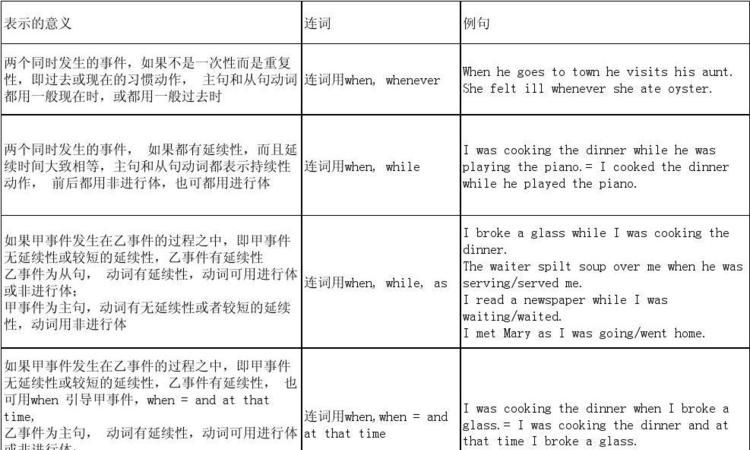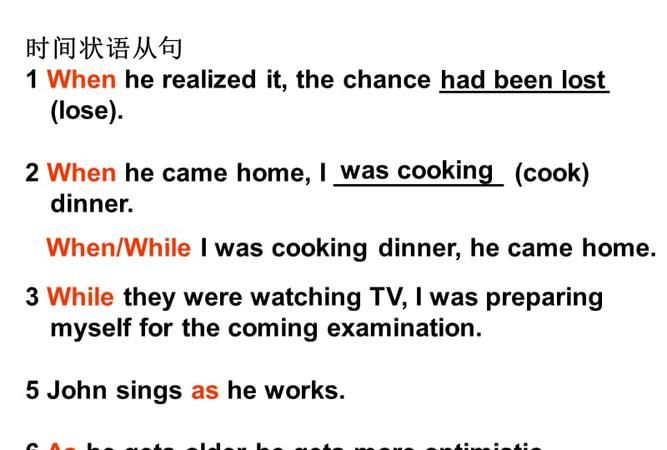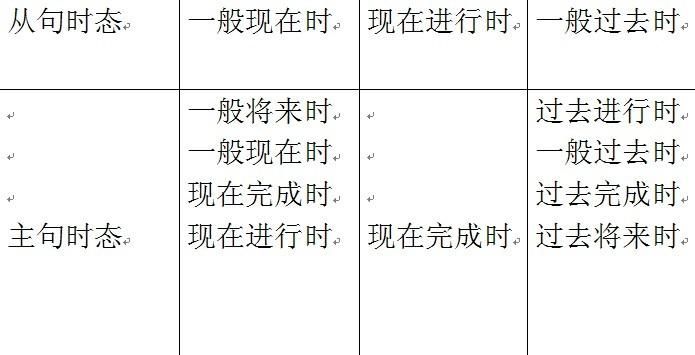本文目录
现在分词作状语的语法功能
现在分词作状语语法总结
☆一般来说,-ing形式表示主动、进行;过去分词表示被动、完成。
☆-ing形式作状语,可以表示时间、原因、结果、条件、让步、行为方式、伴随状况等。
下面是分类总结
▲现在分词作时间状语:
﹡Seeing my parents waving in the crowd,I went running to them.
﹡Crossing the road, the old man was knocked over by a car.
=When he was crossing the road, the old man was knocked over by a car.
﹡(When) Hearing the news, he got frightened.
= When he heard the news, he got frightened.
﹡Having eaten his dinner, the boy rushed out.
﹡Hearing their teacher's voice, the pupils stopped talking at once.
﹡Having received his letter, I decided to write back.
▲现在分词作原因状语:
Being a teacher,you should help your students in every way.
Being poor, he couldn’t afford a TV set.
Not knowing her address, I can't write to her.
Having lived with the girl for 5 years, we all know her very well.
Having eaten too much, he couldn’t go to sleep.
▲现在分词作结果状语:
﹡There is mud and water everywhere, making it difficult to travel from place to place.
making it difficult to travel from place to place 是结果状语。
现在分词作结果状语表示一种必然性(自然结果)。(making 可以改为 which makes,相当于一个前因后果的非限制性定语从句。)
﹡He comes home late every evening, making his wife very angry.
他每天回来得很晚,这是他的妻子很生气。
=He comes home late every evening, which makes his wife very angry.
=He comes home late every evening, and it makes his wife very angry.
﹡Mary failed all her exams, making both her parents very angry.
玛丽未能通过一门考试,这是她父母非常生气。
﹡European football is played in more than80countries,making it one of the most popular games in the world.
﹡The child slipped and fell, hitting his head against the door.
﹡Her husband died ten years ago, leaving her with three children to look after.
﹡Their car was caught in a traffic jam, thus causing the delay.
﹡She threw the toy on the ground, breaking it into pieces.
﹡The song is sung all over the country, making it the most popular song
﹡The child fell, striking his head against the door and cutting it.

现在分词作状语例句带翻译
分两部分(现在分词和过去分词)为楼主解读
1)【现在分词做状语】
现在分词短语可以用作状语,修饰句子中由谓语表示的主要动作.这个状语可以表示动作发生的时间、原因、结果、条件、方式或表示主要动作发生的伴随情况,通常相当于一个状语从句或并列分句.一般说来,这种结构的逻辑主语就是句子的主语.下面分述如下:
一、作时间状语
如果现在分词的动作和主谓语的动作同时发生,分词用一般式,有时其前可以加上连词while或when.例如:
①Hearing the news,they all jumped with joy.(=When they heard the news,they...)
听到这个消息时,他们都高兴得跳了起来.
②Walking slowly across the grass,he pointed the gun at the lion and fired.
他慢慢地走过草地,把枪对准狮子就射击了.
③One day,while walking along the sands towards his boat,Crusoe saw in the sand the mark of a man's foot.
有一天,克鲁索沿着沙滩走向他的船时,在沙子里看见一个人的脚印.
如果现在分词的动作结束之后,谓语动词的动作才发生,现在分词应用完成式.这时分词所表示的动作有一定的持续性.如果用一般式就会给人感觉到似乎是"某人在做某事时就开始做某事",容易产生误解.但是,如果现在分词是hear,see等表示感官的动词或是leave,arrive,turn,open等表示位置转换或情况改变的动词,现在分词所表示的动作发生后,主句的动作往往紧接着发生,那就不必用完成式,仍用一般式.例如:
①Having watered the flowers(=After/When he had watered the flowers),he began to cut the grass.
他把花浇好后,开始割草.
②Having eaten his dinner,the boy rushed out.
那男孩吃完了饭就跑出去了.
③Hearing the footstep below(=When he heard the footstep below),he rose and went to the top of the stairs.
听见下面脚步声,他站起身来走到楼梯口去.
④Seeing a large cake flying through the air,the driver pulled up quickly.
司机看见一只大蛋糕在空中掠过,赶紧刹车.
二、作方式状语
现在分词作方式状语很容易与伴随状语、同位语、定语相混淆.试分析下列句子:
...But later,people developed a way of printing,using rocks.
……但是以后,人们利用石块发展了印刷术.
有人对该句using rocks提出了以下看法:
1)把它视作相当于一个非限制性定语从句.
2)把它视作a way of printing的同位语.
3)把它视作状语,表示伴随情况或方式.
笔者赞成第三种看法,表示方式状语(但不是伴随状语).因为句中using rocks表明人们用什么方法发明了一种印刷方法,是涉及到用how或by what means的回答问题,所以,如果把句中using前的逗号去掉,改为by,则句意保持不变.又如:
He earns a living by driving.他靠开卡车谋生.
They would be ableto reply to our signals by using similar methods.
他们将能用同样的方法回答我们的信号.
三、作目的状语例如:
①Pappy ran out to the gate and told him not to come fooling(=to fool)round there no more.
巴比跑到大门口去叫他不要再到这儿来游荡.(钱歌川,《英语疑难详解》P237)
②The six blind men stood there begging for a meal.(=in order to beg for a meal)六个瞎子站在那儿要饭.
四、作结果状语例如:
①I thought he was making fun of me,and ran faster than ever,reaching(=so that I reached)the school yard quite out of breath.
我想他在拿我开玩笑,就越发跑得快了,到达校园时已经上气不接下气.
②Her husband died ten years ago,leaving her with three children to look after.她丈夫十年前去世了,撇下她和三个孩子.
五、作伴随状语
伴随状语的特点是:它所表达的动作或状态是伴随着句子谓语动词的动作而发生或存在的.例如:
①He sat in the armchair,reading a newspaper.
他坐在扶手椅里读报.
②All night long he lay awake,thinking of the problem.
他整夜躺在床上睡不着,思考着那个问题.
六、作原因状语
现在分词短语作原因状语,尤其是be,feel,know,recognize,fear等状态动词的现在分词(短语),以及现在分词的否定式用作状语时,通常表示
原因.例如:
①Being sick,I stayed at home.我因病呆在家中.
②Not knowing her address,I can't write to her.由于不知道她的地址,我没法给她写信.
③Not having done(=As he has not done)his homework,he stayed at home.
由于他没完成作业,只好呆在家里.
七、作条件状语例如:
Taking(=If you take)the path that leads out of the town,you will come to a dense wood.
如果你沿着通向郊外的小道前进,就会走到一片密林处.
八、起补充说明作用
现在分词短语起补充说明的作用与伴随状语有些相似,但严格地说,它不是伴随状语,因为它所表达的情景不与句子的动作相伴而产生,实际上,它起着补充说明的作用,相当于一个并列分句,但比分句简洁、明快.例如:
①My train leaves at six,arriving in Chicago at ten.=...and will arrive in Chicago at ten.
②The visiting Minister expressed his satisfaction with the talks,adding that he had enjoyed his stay here.=...and added that he had enjoyed his stay here.
2)【过去分词作状语】
过去分词作状语
过去分词和-ing分词作状语一样,也可以表示时间、原因、条件、让步、方式或伴随情况等.
①表时间,相当于一个时间状语从句,有时过去分词前可加连词when或while来强调时间概念.如:
Seen from the top of the hill, the city looked like a big garden. 从山顶上看,这个城市就像一个大花园.
Accepted by the Party, he decided to devote his life to the cause of the Party.
入党以后,他决定献身于党的事业.
②表原因,相当于一个原因状语从句.如:
Deeply moved by the story, the excited people stopped quarrelling with each other.
激动的人们被那个故事深深地感动了,停止了争吵.
Encouraged by the speech, the young people made up their minds to take up the struggle.
受到了讲演的鼓舞,年轻人决定起来从事斗争.
③表条件,相当于一个条件状语从句,有时过去分词前可用if等词.如:
Given another chance, he will do better.再给他一次机会,他会做得更好.
Compared with your brother, you should make greater efforts to study English.
和你哥哥相比,你应该更加努力学习英语.
If heated, water can be turned into steam. 水如果被加热,会变成水蒸气.
④表让步,相当于一个though/although引导的让步状语从句.如:
Exhausted by the running, they went on running after the robber.
尽管已经跑得筋疲力尽,他们还是继续追赶着那个强盗.
Laughed at by many people, he continued his study. 尽管被许多人嘲笑,他还是继续他的研究.
⑤表方式或伴随情况.如:
The old man went into the room, supported by his wife.那个老人在他的妻子的搀扶下走进了房间.
Seated at the table, my father and I were talking about my job. 我和父亲坐在桌子旁边讨论着我的工作问题.

现在分词作状语的例句
一、作时间状语 如果现在分词的动作和主谓语的动作同时发生,分词用一般式,有时其前可以加上连词while或when。例如: ①Hearing the news,they all jumped with joy.(=When they heard the news,they...) 听到这个消息时,他们都高兴得跳了起来。 ②Walking slowly across the grass,he pointed the gun at the lion and fired. 他慢慢地走过草地,把枪对准狮子就射击了。 ③One day,while walking along the sands towards his boat,Crusoe saw in the sand the mark of a man's foot. 有一天,克鲁索沿着沙滩走向他的船时,在沙子里看见一个人的脚印。 如果现在分词的动作结束之后,谓语动词的动作才发生,现在分词应用完成式。这时分词所表示的动作有一定的持续性。如果用一般式就会给人感觉到似乎是"某人在做某事时就开始做某事",容易产生误解。但是,如果现在分词是hear,see等表示感官的动词或是leave,arrive,turn,open等表示位置转换或情况改变的动词,现在分词所表示的动作发生后,主句的动作往往紧接着发生,那就不必用完成式,仍用一般式。例如: ①Having watered the flowers(=After/When he had watered the flowers),he began to cut the grass. 他把花浇好后,开始割草。 ②Having eaten his dinner,the boy rushed out. 那男孩吃完了饭就跑出去了。 ③Hearing the footstep below(=When he heard the footstep below),he rose and went to the top of the stairs. 听见下面脚步声,他站起身来走到楼梯口去。 ④Seeing a large cake flying through the air,the driver pulled up quickly. 司机看见一只大蛋糕在空中掠过,赶紧刹车。 二、作方式状语 现在分词作方式状语很容易与伴随状语、同位语、定语相混淆。试分析下列句子: ...But later,people developed a way of printing,using rocks. ……但是以后,人们利用石块发展了印刷术。 有人对该句using rocks提出了以下看法: 1)把它视作相当于一个非限制性定语从句。 2)把它视作a way of printing的同位语。 3)把它视作状语,表示伴随情况或方式。 笔者赞成第三种看法,表示方式状语(但不是伴随状语)。因为句中using rocks表明人们用什么方法发明了一种印刷方法,是涉及到用how或by what means的回答问题,所以,如果把句中using前的逗号去掉,改为by,则句意保持不变。又如: He earns a living by driving.他靠开卡车谋生。 They would be ableto reply to our signals by using similar methods. 他们将能用同样的方法回答我们的信号。 三、作目的状语例如: ①Pappy ran out to the gate and told him not to come fooling(=to fool)round there no more. 巴比跑到大门口去叫他不要再到这儿来游荡。(钱歌川,《英语疑难详解》P237) ②The six blind men stood there begging for a meal.(=in order to beg for a meal)六个瞎子站在那儿要饭。 四、作结果状语例如: ①I thought he was making fun of me,and ran faster than ever,reaching(=so that I reached)the school yard quite out of breath. 我想他在拿我开玩笑,就越发跑得快了,到达校园时已经上气不接下气。 ②Her husband died ten years ago,leaving her with three children to look after.她丈夫十年前去世了,撇下她和三个孩子。 五、作伴随状语 伴随状语的特点是:它所表达的动作或状态是伴随着句子谓语动词的动作而发生或存在的。例如: ①He sat in the armchair,reading a newspaper. 他坐在扶手椅里读报。 ②All night long he lay awake,thinking of the problem. 他整夜躺在床上睡不着,思考着那个问题。 六、作原因状语 现在分词短语作原因状语,尤其是be,feel,know,recognize,fear等状态动词的现在分词(短语),以及现在分词的否定式用作状语时,通常表示 原因。例如: ①Being sick,I stayed at home.我因病呆在家中。 ②Not knowing her address,I can't write to her.由于不知道她的地址,我没法给她写信。 ③Not having done(=As he has not done)his homework,he stayed at home. 由于他没完成作业,只好呆在家里。 七、作条件状语例如: Taking(=If you take)the path that leads out of the town,you will come to a dense wood. 如果你沿着通向郊外的小道前进,就会走到一片密林处。 八、起补充说明作用 现在分词短语起补充说明的作用与伴随状语有些相似,但严格地说,它不是伴随状语,因为它所表达的情景不与句子的动作相伴而产生,实际上,它起着补充说明的作用,相当于一个并列分句,但比分句简洁、明快。例如: ①My train leaves at six,arriving in Chicago at ten.=...and will arrive in Chicago at ten. ②The visiting Minister expressed his satisfaction with the talks,adding that he had enjoyed his stay here.=...and added that he had enjoyed his stay here.


以上就是关于现在分词作时间状语例句20个 ,现在分词作状语的语法功能的全部内容,以及现在分词作时间状语例句20个 的相关内容,希望能够帮到您。
